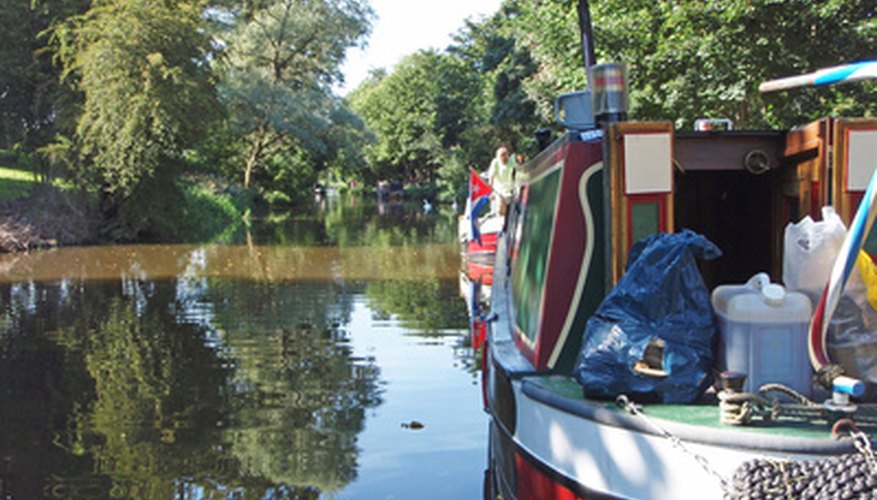The Morso Squirrel is a small, cast-iron stove, often found on canal boats, though it is also used for heating small rooms, cabins and trailer homes. A sturdy, square-shaped stove emblazoned with its distinctive squirrel badge, it has a flat top that acts as a hotplate for kettles and cooking pots. The Squirrel stands on four legs and features a glass-fronted door that can be opened to add fuel. Some models have a back-boiler to heat water for washing, or to run radiators. The Squirrel can burn either wood or coal. Its fire is simply regulated by the opening and closing of two air vents.
- The Morso Squirrel is a small, cast-iron stove, often found on canal boats, though it is also used for heating small rooms, cabins and trailer homes.
- A sturdy, square-shaped stove emblazoned with its distinctive squirrel badge, it has a flat top that acts as a hotplate for kettles and cooking pots.
Pull the handle to open the stove door and allow access to its firebox.
Crumple sheets of newspaper into balls and lay them inside the firebox. Lay dry twigs on top of the newspaper, arranging them in a rough cone or pyramid shape, so the air circulates around them and they burn quickly when the fire is lit.
- Crumple sheets of newspaper into balls and lay them inside the firebox.
- Lay dry twigs on top of the newspaper, arranging them in a rough cone or pyramid shape, so the air circulates around them and they burn quickly when the fire is lit.
Turn the wheel-shaped knob on the firebox door to close the stove's upper vent. Turn the wheel-shaped knob on the door below the firebox, to open the stove's lower vent. This will allow air to enter the stove beneath the fire, causing it to burn fiercely once it is lit.
Strike a match and light the edge of the newspaper. Leave the door of the stove ajar for around 5 minutes, until the twigs are alight and there is a strong current of air or "chimney draft" travelling up the stove pipe. At this point, close the door.
Wrap a cloth around the handle of the stove door, as the handle can become very hot when the fire is burning. Pull the handle to open the stove door.
- Wrap a cloth around the handle of the stove door, as the handle can become very hot when the fire is burning.
Grip a lump of coal in iron tongs and set it on the burning twigs. Add around 5 more lumps in the same way. Arrange the lumps with the largest at the bottom, trying to maintain the cone or pyramid shape, as this helps the fire burn well. When the fire is burning strongly, reposition lumps of burning coal by prodding them into place with an iron poker.
Close the stove door, and turn the knob on the lower vent to close it partially. This restricts the air supply and slows the rate at which the fire burns. If you close the vent completely, the fire will smoulder and go out. Using the knob, adjust the lower vent to attain desired burn rate.
Add more coal to the stove once the fire is burning well. Use a shovel to add several lumps of coal at a time, but avoid piling the stove with all your fuel at once, as this can smother the fire and cause it to go out. It is better to add a little fuel every now and again.
- Add more coal to the stove once the fire is burning well.
- Use a shovel to add several lumps of coal at a time, but avoid piling the stove with all your fuel at once, as this can smother the fire and cause it to go out.
Close the lower vent until the coals of the fire glow an even red when you wish to leave the stove burning -- for example overnight -- and open the vent wider when you want it to put out more heat. If burning wood rather than coal, close the lower vent completely after the fire has been lit and is burning well, and open the upper vent instead. Wood burns better when the air supply comes from above, so use this secondary vent to regulate the burning of firewood.
Allow the fire to go out completely. Close up the vents to hasten this, if necessary.
Open the stove door and use the poker to prod cinders and ashes through the bottom grate of the firebox and into the ash pan below.
Pull the handle to open the smaller door below the firebox. Pull out the stove's cast-iron ash pan. Empty the ash pan's contents into an iron bucket. Sweep any loose ashes into the bucket with a dustpan and brush. Replace the ash pan.
TIP
If your Morso Squirrel stove is a model that has only one knob, situated on the stove's lower door, make sure this knob is turned so the vent is fully open when starting the fire. Then partially close the vent until the stove burns as you wish. The stove does have a secondary air supply, controlled by a handle directly beneath the ashtray. Pull this to increase the air flow and cause the fire to flare up.
